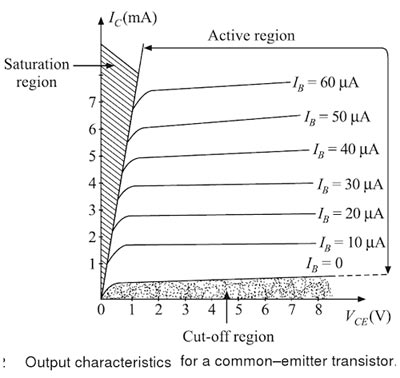When the collector junction in a transistor is biased in the reverse direction and the emitter junction in the forward direction, the transistor is said to be is the:-
Right Answer is:
Active region
SOLUTION
The output characteristics can be divided into three distinct regions. namely, the active region, the saturation region, and the cut-off region.
Active Region
In the active region, the collector junction is reverse biased and the emitter junction is forward biased. In the output characteristics, the active region is the area to the right of the ordinate VCE= a few tenths of a volt and above IB = 0. In this region, the transistor output current responds most sensitively to an input signal. If the transistor is to be used as an amplifying device without appreciable distortion, it must be restricted to operate in this region.

In the active region, IC is practically independent of VCE and is determined only by lE. The active region lies between cutoff and saturation points.
Saturation Region
The region of the output characteristics where both junctions (emitter and collector) are forward biased, is known as the saturation region of the transistor.
The saturation region is located to the left of the ordinate. VCB is slightly positive for p-n-p transistor in this region. This forward biasing of the collector-base junction causes the collector current to change exponentially with the collector-base forward voltage, as in p-n diode. The large change in the collector current for a small change in VCB in the saturation region is thus accounted for. A forward bias implies that the collector p material is at a positive potential relative to the base n material. A hole current thus flows from the collector to the base, i.e., in a direction opposite to the original hole current due to the transistor action. When the forward bias is sufficiently large, the hole flow from the collector to the base predominates, forcing Ic to be positive, as shown in Fig.
Cut-off Region
The region of the output characteristics where both the junctions (emitter and collector) are reverse biased, is known as the cutoff region of the transistor.
In order to cut off the transistor, it is not enough to reduce lB to zero. Instead, it is necessary to reverse bias the emitter junction slightly. The cut-off is thus defined as the condition where the collector current is equal to the reverse saturation current ICO and the emitter current is zero.
Note:-
Cutoff region: in this region transistor acts as an off switch.
Saturation region: transistor acts as on switch.
Active region: transistor acts as an amplifier
